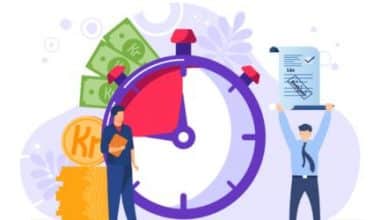Short-term loans are easy to apply for and receive. They frequently require little to no collateral, making them appear very appealing in a pinch. However, in exchange for the convenience, you will pay high-interest rates and fees. The repayment period may also be limited to a few weeks. This means that short-term loans should be approached with caution.
But there is more, and this article will walk you through every piece of information regarding short-term loans to help you decide.
What Exactly Is a Short-Term Loan?
A short-term loan is a loan obtained to meet a temporary personal or business capital need. As a type of credit, it entails repaying the principal amount plus interest by a specified due date, which is usually within a year of receiving the loan.
A short-term loan is an excellent option, particularly for small businesses or start-ups not yet eligible for a bank credit line. The loan involves smaller amounts ranging from $100 to $100,000. Short-term loans are appropriate not only for businesses but also for individuals who are experiencing a temporary, unexpected cash flow problem.
How Does a Short-Term Loan Work?
When people need money quickly, a short-term loan can come to their rescue. A company, for example, cannot finance its daily orders if all of its debtors are delaying payments. Banks, credit unions, and financial institutions offer many short-term lending options to businesses to help them cover their day-to-day expenses.
These loans come in a variety of shapes and sizes. Banks, financial institutions, and suppliers can all provide short-term loans. Borrowers can apply for short-term loans online or in person. The lender investigates the loan applicant’s creditworthiness, discusses the terms, completes paperwork, and releases the funds once the loan is approved.
What is an Example of Short-Term Loans?
A bank’s overdraft facility is an example of a short-term loan. If the borrower’s account does not have enough funds to make a payment, the bank will extend additional funds. The bank then charges the borrower for the service.
When Should You Consider a Short-Term Loan?
A short-term loan may be worth considering when you’re in a pinch and need money fast because they typically provide quick funding. Because the requirements for approval are primarily based on salary and other factors, these types of loans can also be a good choice if you have bad credit or no credit history.
If you use a short-term loan responsibly, making on-time payments and repaying it quickly, this type of borrowing can also help you improve your credit score. Furthermore, if you’re looking for a way to get out of debt quickly, a short-term loan may be a good option because the repayment period is typically 18 months or less.
However, you should only consider this type of borrowing if you are confident in your ability to repay the debt, as the interest rates on short-term loans are exorbitant, reaching 400% or higher.
Features of Short-Term Loan
- The annual percentage rate (APR) or interest rates are typically set high because a short tenure limits lenders’ ability to make adequate profits. Typically, the tenure is less than a year, and in some cases as little as 1-2 years, resulting in less accrued interest. Long-term debts generate higher earnings for lenders because repayments typically last for many years, piling up the interest amount.
- Lenders charge a high-interest rate to compensate for the potential default loss because these loans are mostly unsecured. Also because an unsecured loan is not backed by collateral, no property can be sold to recover the debt if the debtor defaults.
- Borrowers must have a good credit score to ensure their creditworthiness for timely repayments because many lenders do not require collateral,
- When compared to other types of loans, the borrowing amount is usually small.
- Both the principal and the interest must be repaid in full within the loan’s term. Many people have a weekly repayment plan.
- Many borrowers prefer short-term loans from direct lenders, which eliminate the need for intermediaries like credit brokers. A broker’s delay could cause an applicant’s loan to be delayed. Furthermore, direct lending for short-term loans frequently includes online services, faster approval, and loan sanction. As a result, direct lenders were in high demand at Covid-19.
Types of Short-Term Loans
Let us go over some of the different types in detail.
#1. Line of Credit (LOC)
A line of credit is a type of loan in which a bank or financial institution establishes a maximum loan amount that an individual may borrow. The borrower has the option of repaying the loan in full or in installments. Borrowers are not permitted to withdraw more than the permitted limit, which is determined by their creditworthiness.
In exchange, the bank charges only on the amount withdrawn, not on the loan’s remaining available balance. When the dues are due, the borrower will be unable to withdraw until the principal and interest are paid in full. The borrower can resume using the line of credit service after paying the dues. LOC works best when credit is needed on a regular basis.
#2. Short-Term Bank Loanse
Loans, unlike LOCs, expire after a set period of time. As a result, if the borrower wants to borrow again, they may need to apply for a new loan. A personal loan to finance a wedding is one example.
#3. Bank Overdraft
One of the most common types of credit facility is a bank overdraft. If a bank account holder does not have enough money in their account to cover the amount they want to withdraw, the bank will cover the difference. In exchange, the bank charges interest, which some banks charge at exorbitant rates.
Every day, businesses conduct numerous transactions, resulting in a rapidly declining bank balance. A bank overdraft service prevents operational disruption caused by rejected payments due to a low balance. Customers must, however, exercise caution when using bank overdrafts. Some reputable providers have charged their customers unaccrued interest. These banks have frequently paid millions of dollars in fines for such violations.
#4. Merchant Cash Advances
They are appropriate for businesses that have a high volume of credit/debit card sales rather than cash sales, i.e., their customers make card payments during purchases. A financial institution agrees to advance a lump sum amount to the borrower under this facility. This amount is then recovered by the lender as a percentage of the borrower’s daily sales.
#5. Invoice Financing (Receivables Financing)
A company uses this facility to borrow money from a bank or financial institution in exchange for money owed to it by customers, i.e., account receivables. When customers take their time paying their bills, a company can borrow in the meantime to meet its liquidity needs. Lenders charge an invoice financing fee, which is deducted from the loan amount. Receivables can be used as collateral, allowing the bank to rely on them if the borrower defaults.
#6. Payday Loans
The borrower’s earnings determine the borrowing amount for payday loans, usually as a percentage of their earnings. Repayment is due when the next paycheck/income is received. Payday loans have unreasonably high interest rates and can be obtained online or in stores.
Advantages of Short-Term Loans
People do not always have to take out a mortgage loan when they need money right away. A short-term credit facility enables people to borrow a small sum of money from financial institutions to cover needs such as a medical emergency or business expenses.
- Faster Approval: Unlike other types of loans, short-term loans do not require lengthy approval processes.
- Lower Accrued Interest: The borrower pays less interest because the repayment period is shorter.
- Increases Credit Score: Obtaining such a loan and repaying it without default can help the borrower’s creditworthiness.
- Unsecured: These loans are typically unsecured, and borrowers are not required to provide collateral, making it easier to obtain funds on short notice.
- Economic Well-Being: Interest rates on interbank overnight borrowings are an important tool that central banks use to control inflation or deflation. This is because changes in short-term lending rates eventually affect the borrowing costs of all loans. When a central bank wants to boost growth, it lowers interest rates, which stimulates investment and consumption, resulting in higher GDP, wages, and employment.
Disadvantages of Short-Term Loans
- Lower Borrowing Amount: The borrower may require a larger amount that cannot be obtained through short-term credit.
- Small-time Borrowers’ Predicament: Some payday loans charge up to 400% interest per year. High APRs make it difficult for those with limited resources to manage repayments. Any increase in interest rates or penalties may put additional strain on the system, potentially leading to default and a lower credit score.
- Unfair Means: Many payday and credit card lenders have made headlines over the years for harassing their debtors. According to a 2020 study, over 3000 borrowers were issued arrest warrants for payday loans, vehicle title loans, and other high-cost lending.
- Credit Score: Because the loans are unsecured, those with low credit scores frequently struggle to obtain funds from reputable sources. Many short-term loan providers have emerged over the years, offering loans to those with bad credit. To compensate for their lack of creditworthiness, they charge exorbitant interest rates. More expensive loans increase the likelihood of default, which can further harm the credit score.
Alternatives for Short-term Loans
Some short-term loan options may be suitable for you. While these options may not be suitable for everyone, you should consider one or more of the following:
- Borrowing from friends and family: If you borrow money from friends and family, make sure that both of you are clear on whether and how the money should be repaid — otherwise, the loan can harm your relationship.
- Borrowing from your home’s equity: If you have a larger or non-urgent emergency and own your home, you may be able to tap into its equity with a home equity loan or line of credit. These alternatives typically take several weeks.
- Buy now, pay later loans: Buy now, pay later services are becoming increasingly popular. These lenders and services allow borrowers to make interest-free payments over a set period of time, typically six weeks. However, the terms vary greatly, and some plans are much longer. While longer repayment terms may incur interest, buying now and paying later can be a less expensive option than traditional short-term loans.
Read Also: 5 Best Business Loans for Bad Credit 2023 (Updated)
- Credit card: If you can pay for your emergency with a credit card, it may be a better and less expensive option than taking out a short-term loan.
- Personal Loans: Personal loans can also be used as an alternative to short-term loans. The terms and rates you receive vary depending on your credit, but they are usually significantly better than most short-term loans. Personal loans usually have a set repayment period of a few years. Find a lender that does not charge a prepayment penalty if you want to pay off the loan early. Lenders such as Lightstream, SoFi, and Upstart do not charge fees for early loan repayment.
- Personal line of credit: A personal line of credit is another option for covering unexpected expenses in an emergency or assisting with a cash shortage. A personal line of credit is an unsecured revolving account with a variable interest rate that you can draw from as needed and then repay with interest. It functions similarly to a credit card.
- Salary advances: Some employers may provide salary advances, which are a type of borrowing in which you are paid in advance for future wages. After that, the advance would be deducted from your future earnings. Not all employers provide this type of program, and those that do usually impose some restrictions or limitations.
How can I Obtain a Short-Term Loan?
There are many ways to get a loan quickly, one of which is that many banks offer online loan applications. Some personal loan providers can lend money within 24 hours if approved. Furthermore, some institutions offer attractive rates to those with excellent credit.
Conclusion
Although short-term loans are convenient and appear to be a great way to solve a temporary problem, they are fraught with danger. Fees and interest rates can reach 400%, with payback terms as short as two weeks. Missed payments will lower your credit score and cost you more money in late fees, penalties, and interest. This can result in a difficult to break cycle of borrowing. Before applying for this type of loan, consider all of your options.
Related Articles
- LOCAL FINANCE COMPANY: Top Best Local Finance Companies 2023
- Can You Get a Credit Card With Your Current Credit Score?
- LOAN TERM: Definition, Types and How It Works
- TERM LOAN: Meaning, Companies, Online & Bad Credit
- SHORT TERM SOURCES OF FINANCE: BEST OPTIONS FOR ANY BUSINESS (+DETAILED GUIDE)






